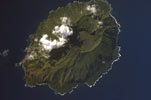Mariana Islands
 The Micronesian island group of the Mariana Islands forms a curving chain
of 15 main islands located in an extremely tectonically active region of the western Pacific. Spanning across 800 km of ocean, the
Mariana Islands are located around 2,500 km east of the Philippines and a similar distance north of Papua New
Guinea. 14 of the islands form the Commonwealth of the Northern Mariana Islands (CNMI). The southernmost island of the group
— Guam — is a territory of the United States.
The Micronesian island group of the Mariana Islands forms a curving chain
of 15 main islands located in an extremely tectonically active region of the western Pacific. Spanning across 800 km of ocean, the
Mariana Islands are located around 2,500 km east of the Philippines and a similar distance north of Papua New
Guinea. 14 of the islands form the Commonwealth of the Northern Mariana Islands (CNMI). The southernmost island of the group
— Guam — is a territory of the United States.
Guam is, by far, the largest of the Mariana Islands with an area of 541 km² — larger than the rest of the islands combined. The islands of the CNMI (all those islands located to the north of Guam) have a combined land area of 479 km², with Saipan and Tinian being the major landmasses (122 km² and 102 km², respectively). The CNMI is a self-governing commonwealth in political union with the US.
In the north the islands are geologically young, having been formed within the last 5 million years. Their formation continues today with volcanic activity frequently observed on islands such as Anatahan (2005), Pagan (1993) and Farallon de Pajaros (1967). In the south the islands are older, with Guam being around 30 million years old. The southern islands are composed of volcanic rocks that have been overlain with coral-derived limestone. Subsequent tectonic movements and changing sea levels have raised many of the islands in the south considerable heights above sea level forming terraces and high cliffs.
The Mariana Islands are a classic example of an island arc formation — on a larger scale the islands are part of the chain of volcanoes known as the Izu-Bonin-Mariana Arc that includes the Ogasawara-shotō (Bonin Islands), Kazan-rettō (Volcano Islands) and Izu-shotō to the north. In this region, where the western subducting edge of the Pacific plate plunges beneath the Philippine plate, is found the most volcanically active convergent plate boundary on Earth. There are thought to be at least 50 submarine volcanoes in the region as well as 11 emergent volcanic peaks.
